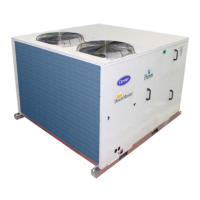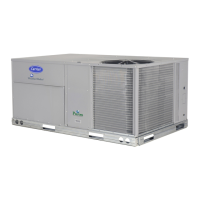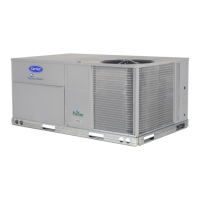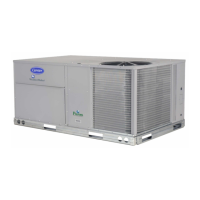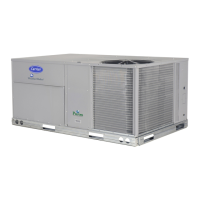START-UP
Use the following information and Start-Up Checklist on
page CL-1 to check out unit PRIOR to start-up.
Unit Preparation — Check that unit has been installed
in accordance with these installation instructions and all
applicable codes.
Service Valves — Ensure that suction, discharge, and
liquid line service valves are open. Damage to the compres-
sor could result if they are left closed.
Internal Wiring — Check all electrical connections in
unit control boxes; tighten as required.
Crankcase Heater(s) — Heater(s) is energized as long
as there is power to unit and compressor is not operating.
IMPORTANT: Unit power must be on for 24 hours
prior to start-up. Otherwise, damage to compressor may
result.
Compressor Mounting — Compressors are inter-
nally spring mounted. Do not loosen or remove compressor
holddown bolts.
Refrigerant Service Ports — Each refrigerant sys-
tem has a total of 3 Schrader-type service gage ports. One
port is located on the suction line, one on the compressor
discharge line, and one on the liquid line. In addition Schrader-
type valves are located underneath the low-pressure switches.
Be sure that caps on the ports are tight.
Compressor Rotation — It is important to be certain
the compressors are rotating in the proper direction. To de-
termine whether or not compressors are rotating in the proper
direction:
1. Connect service gages to suction and discharge pressure
fittings.
2. Energize the compressor.
3. The suction pressure should drop and the discharge pres-
sure should rise, as is normal on any start-up.
If the suction pressure does not drop and the discharge
pressure does not rise to normal levels:
1. Note that the evaporator fan is probably also rotating in
the wrong direction.
2. Turn off power to the unit.
3. Reverse any two of the incoming power leads.
4. Turn on power to the compressor.
The suction and discharge pressure levels should now move
to their normal start-up levels.
NOTE: When compressors are rotating in the wrong direc-
tion, the unit will have increased noise levels and will not
provide heating and cooling.
After a few minutes of reverse operation, the scroll com-
pressor internal overload protection will open, which will
activate the unit’s lockout and requires a manual reset. Reset
is accomplished by turning the thermostat on and off.
Evaporator Fan — Fan belt and variable pulleys are
factory installed. Remove tape from the fan pulley. See
Table 4 for Air Quantity Limits. See Tables 5-7 for Fan
Performance data. Be sure that fans rotate in the proper
direction. See Tables 8 and 9 for Static Pressure infor-
mation for accessories and options. See Table 10 for fan rpm
at various fan motor pulley settings. To alter fan perfor-
mance, see Evaporator-Fan Performance Adjustment sec-
tion, page 21.
Table 4 — Air Quantity Limits
UNIT
50TJ
MINIMUM CFM MAXIMUM CFM
016 4500 7,500
020 5400 9,000
024 6000 10,000
028 7000 11,250
Condenser Fans and Motors — Fans and motors
are factory set. Refer to Condenser-Fan Adjustment section
(page 22) as required.
Return-Air Filters — Check that correct filters are
installed in filter tracks. See Table 1. Do not operate unit
without return-air filters.
Outdoor-Air Inlet Screens — Outdoor-air inlet screens
must be in place before operating unit.
Accessory Economizer Adjustment — Remove
filter access panel. Check that outdoor-air damper is closed
and return-air damper is open.
Economizer operation and adjustment is described in
Base Unit Operation and Economizer Adjustment sections
(pages 20 and 22), respectively.
SENSOR
LOCATION
HAIRPIN END
SENSOR
LOCATION
HAIRPIN END
50TJ024 50TJ028
NOTE: All sensors are located on the eighth hairpin up from the
bottom.
Fig. 24 — MotormasterT III Sensor Locations
15

